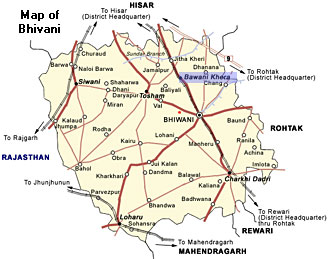 Bawani Khera is a city as well as a municipal committee situated in the Bhiwani District in the state of Haryana in India. The total area covered by the Bhiwani District is 5099 sq. km. Its exact geographical location is between 28.19 deg. and 29.05 deg. north latitude and 75.26 deg. and 76.28 deg. east longitudes. It comprises 442 villages and has a population of 1.42 million. The administrative headquarters of this district are located in the city of Bhiwani, which is approximately 124 kilometres from Delhi. A Rajput named Neem after his wife Bhani set up the city, according to popular belief. The name Bhani in course of time transformed to Bhiyani and afterwards to Bhiwani. The name of the city is mentioned in Ain-e-Akbari. It has been an important centre of business since the time of the Mughals. Bhiwani is known for its several temples. Due to the prtesence of these temples, it is also called the little Kashi. Other notable towns in the district are Loharu, Dadri, Tosham and Bawani Khera. Archaeological excavations in the village of Mitathal in Bhiwani have brought to light traces of pre Harappan and Harappan (Indus Valley Civilization) culture in the region. The famed college for textiles the Technological Institute of Textile and Sciences is situated in the Bhiwani district.
Bawani Khera is a city as well as a municipal committee situated in the Bhiwani District in the state of Haryana in India. The total area covered by the Bhiwani District is 5099 sq. km. Its exact geographical location is between 28.19 deg. and 29.05 deg. north latitude and 75.26 deg. and 76.28 deg. east longitudes. It comprises 442 villages and has a population of 1.42 million. The administrative headquarters of this district are located in the city of Bhiwani, which is approximately 124 kilometres from Delhi. A Rajput named Neem after his wife Bhani set up the city, according to popular belief. The name Bhani in course of time transformed to Bhiyani and afterwards to Bhiwani. The name of the city is mentioned in Ain-e-Akbari. It has been an important centre of business since the time of the Mughals. Bhiwani is known for its several temples. Due to the prtesence of these temples, it is also called the little Kashi. Other notable towns in the district are Loharu, Dadri, Tosham and Bawani Khera. Archaeological excavations in the village of Mitathal in Bhiwani have brought to light traces of pre Harappan and Harappan (Indus Valley Civilization) culture in the region. The famed college for textiles the Technological Institute of Textile and Sciences is situated in the Bhiwani district.
As per the 2001 India census, Bawani Khera has a total population of 17,438. Males make up 53% of the population and females comprise 47%. The city has a mean literacy rate of 56%, lower than the nationwide standard of 59.5%. 63% of the males and 37% of the females are literate. Children less than 6 years of age make up 17% of the population.



















